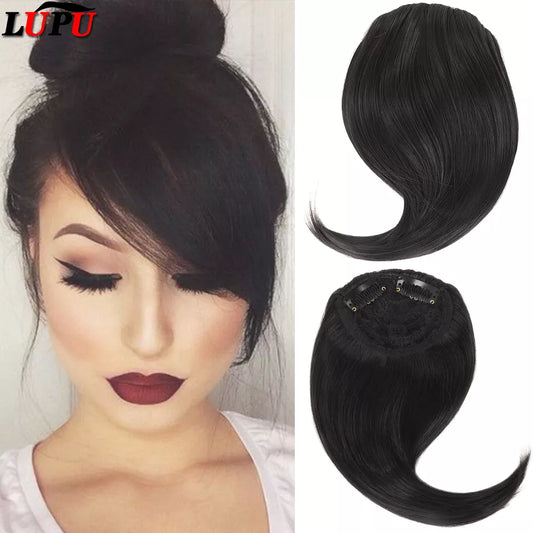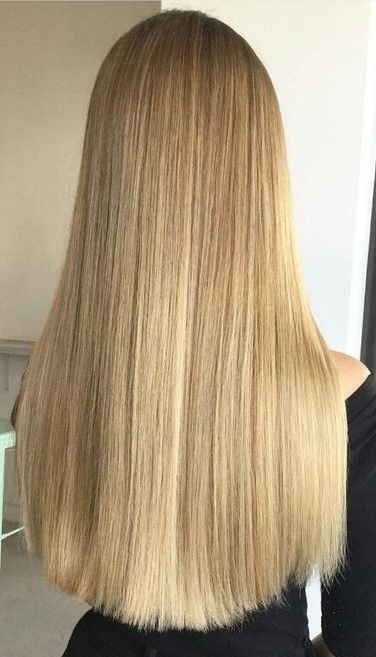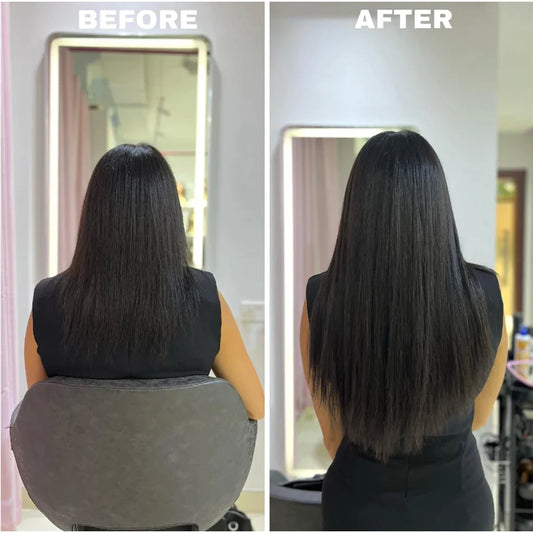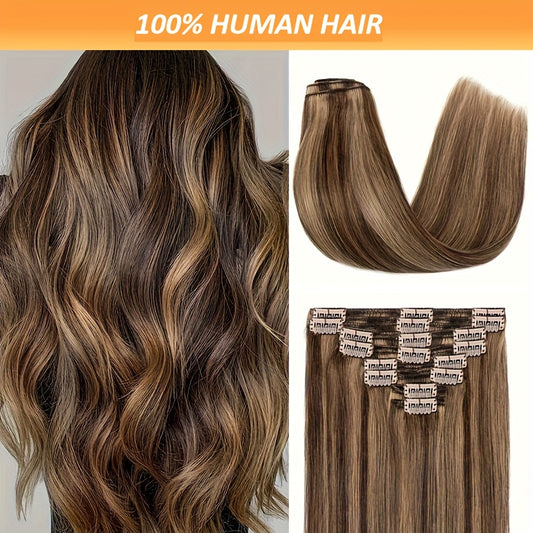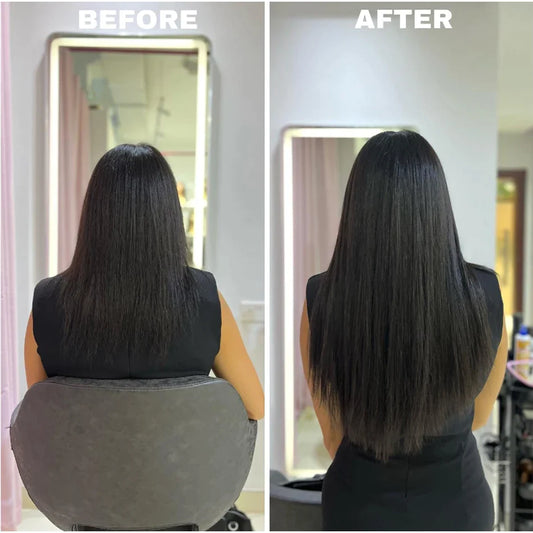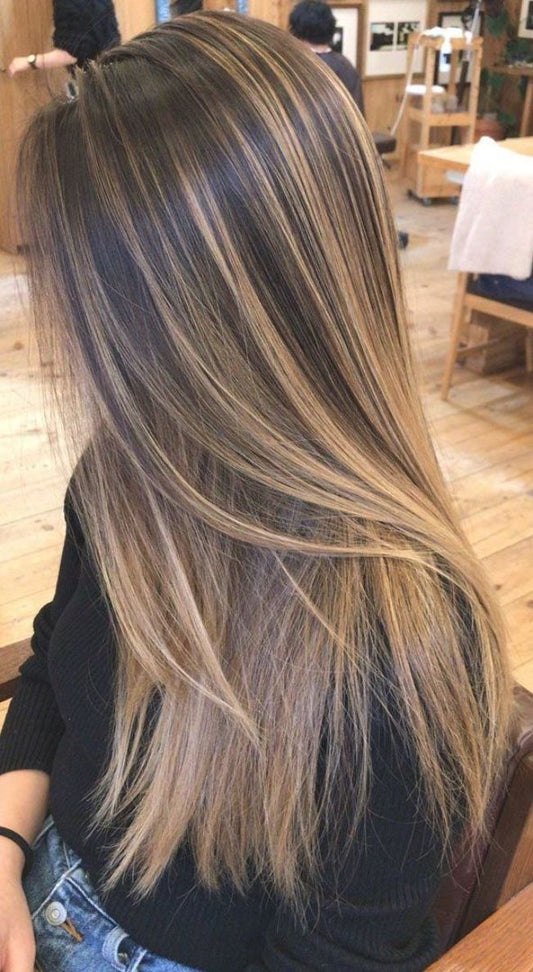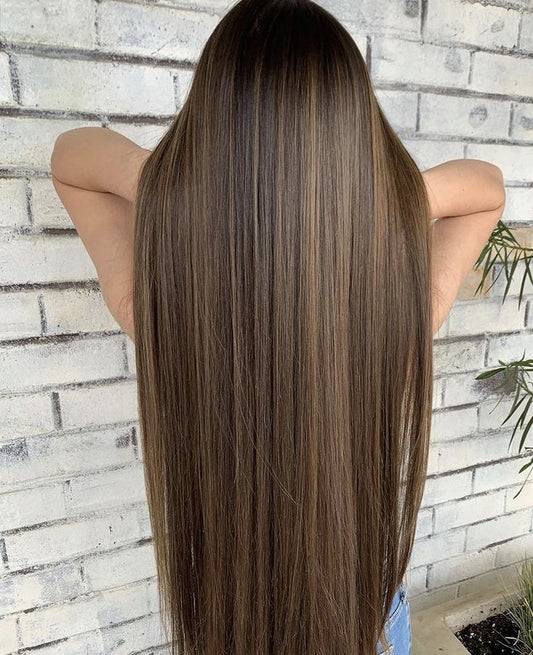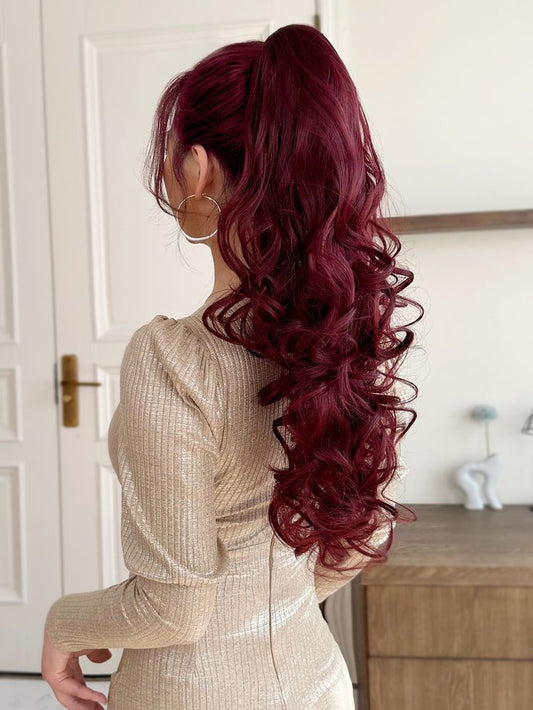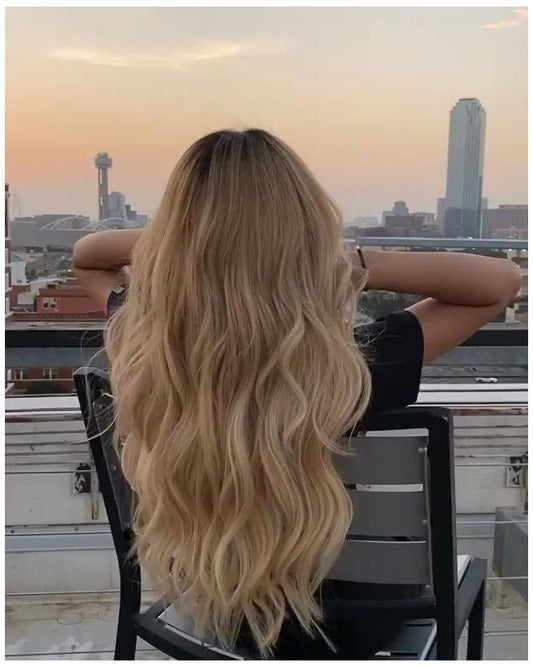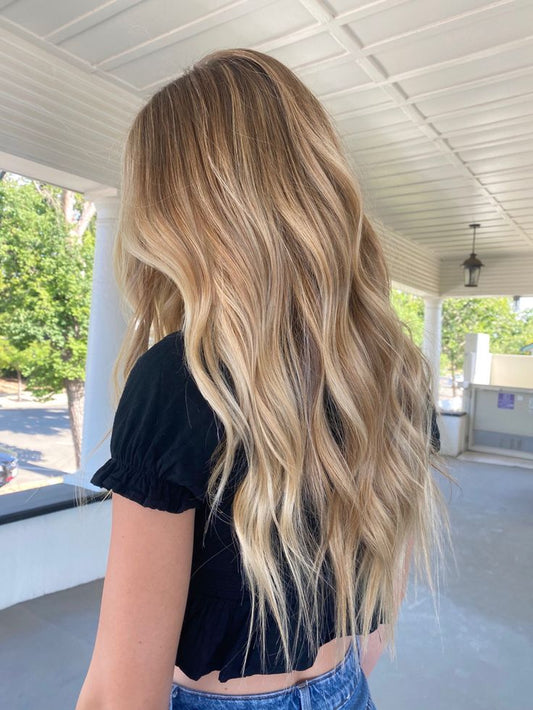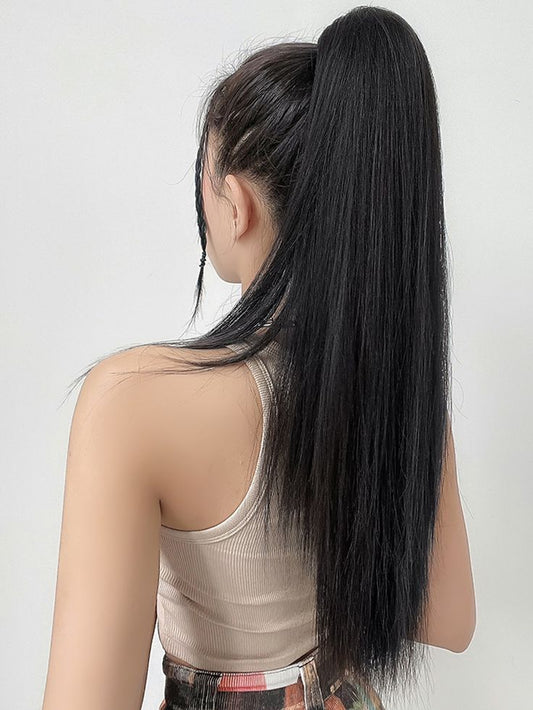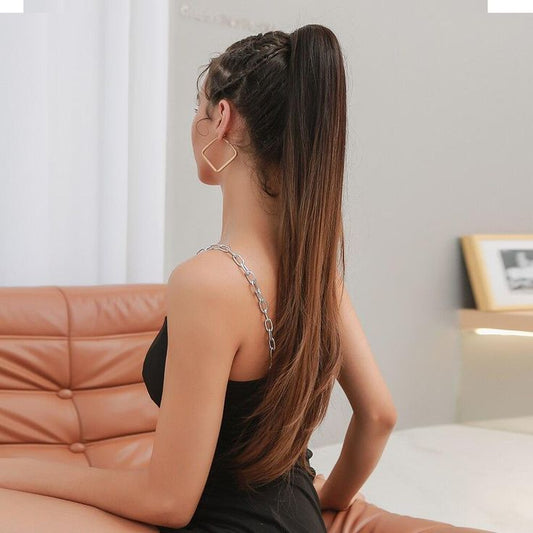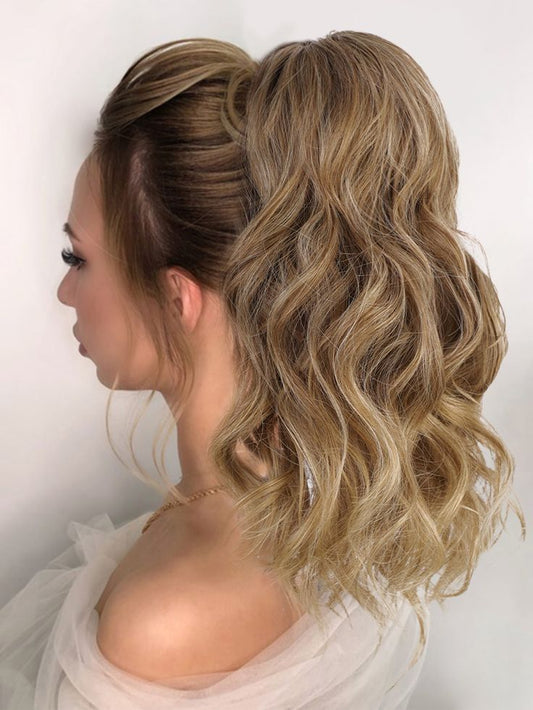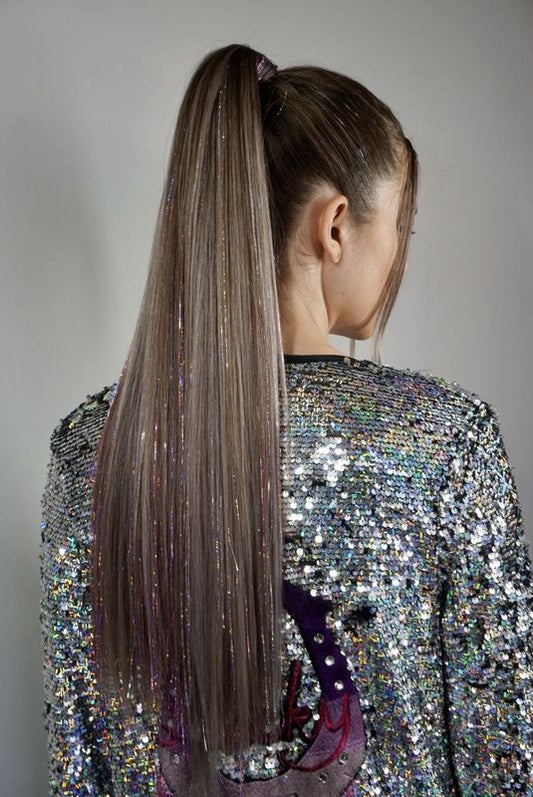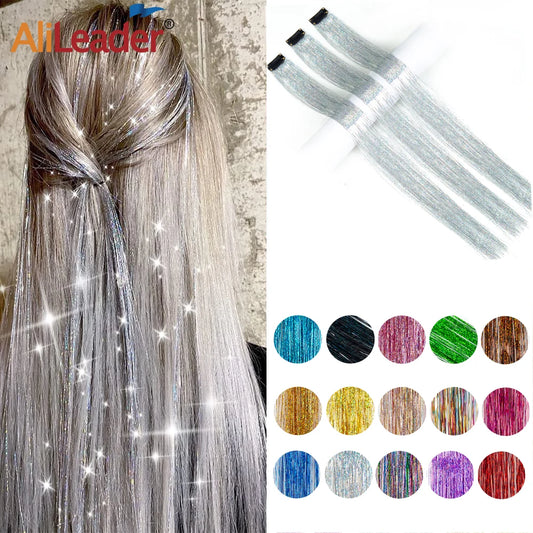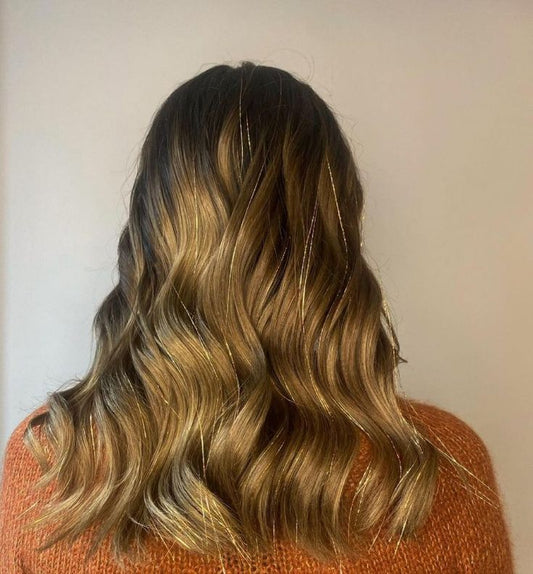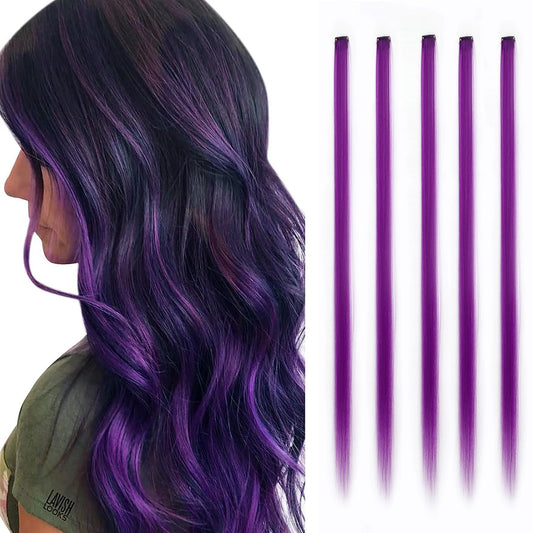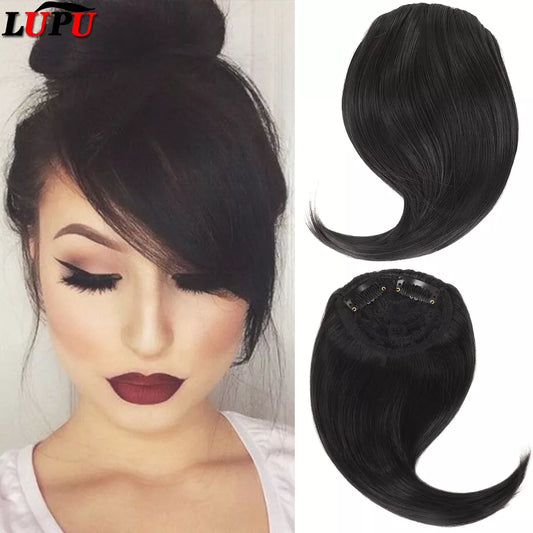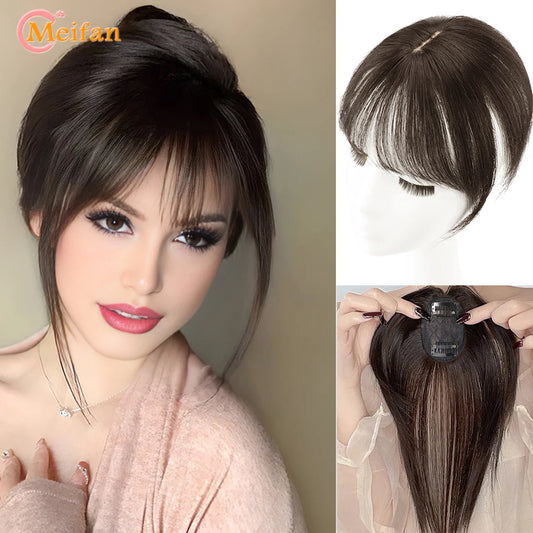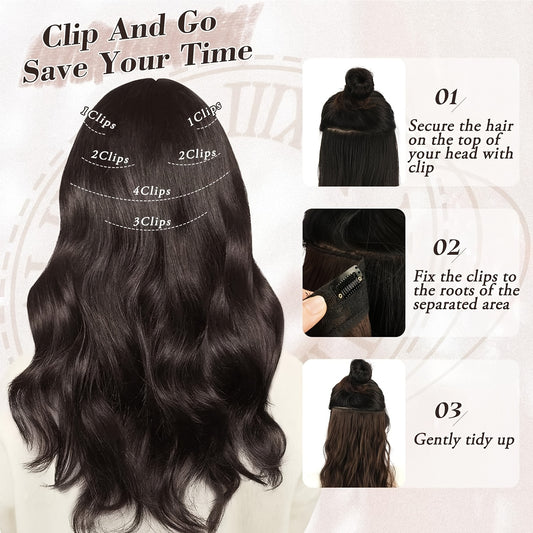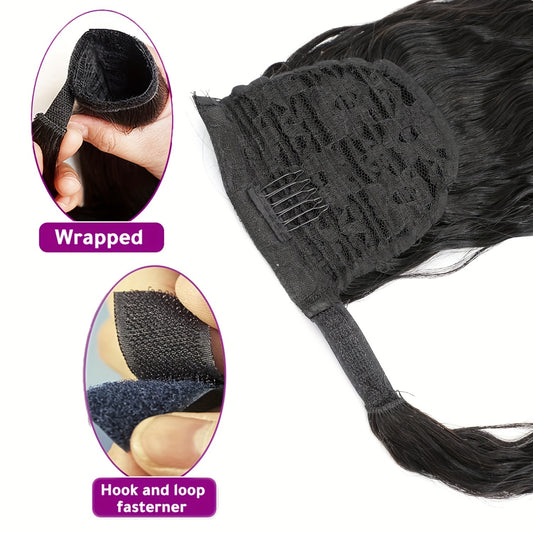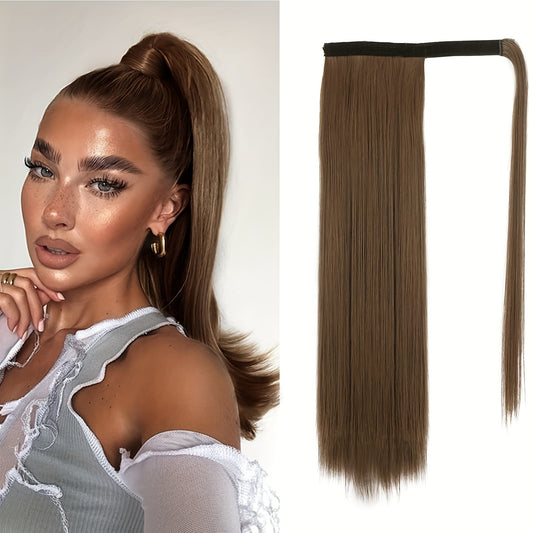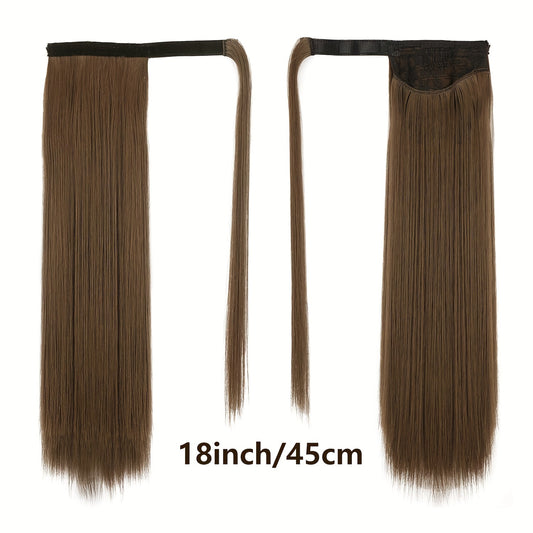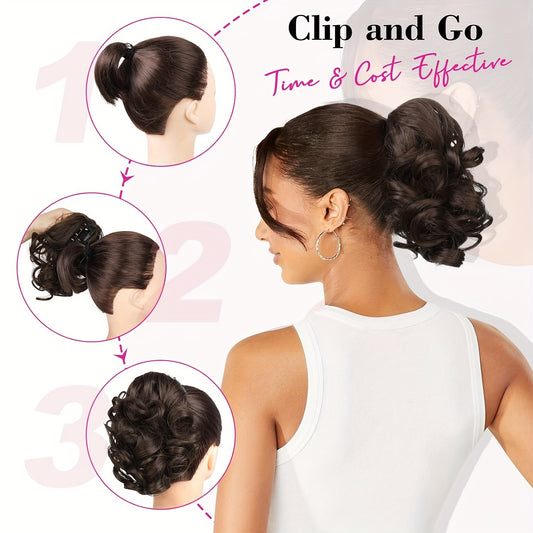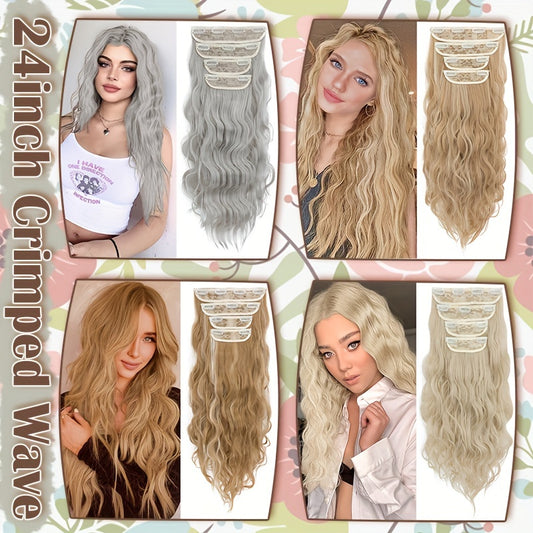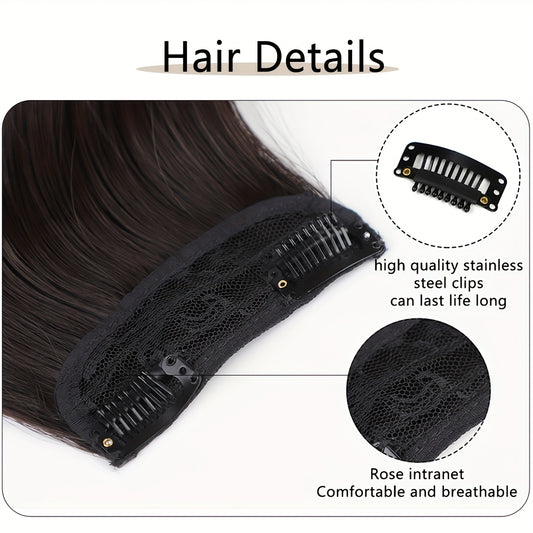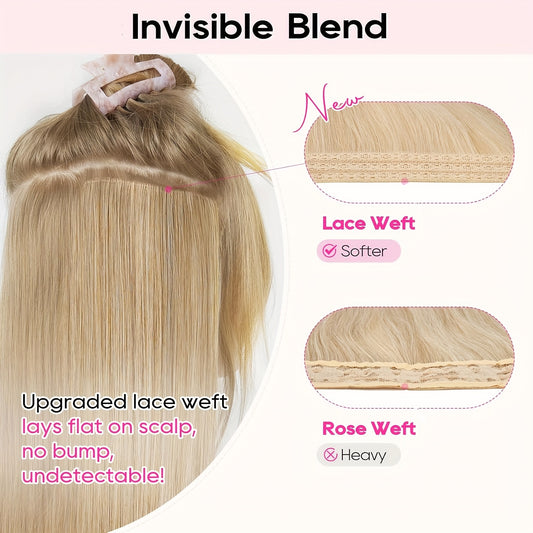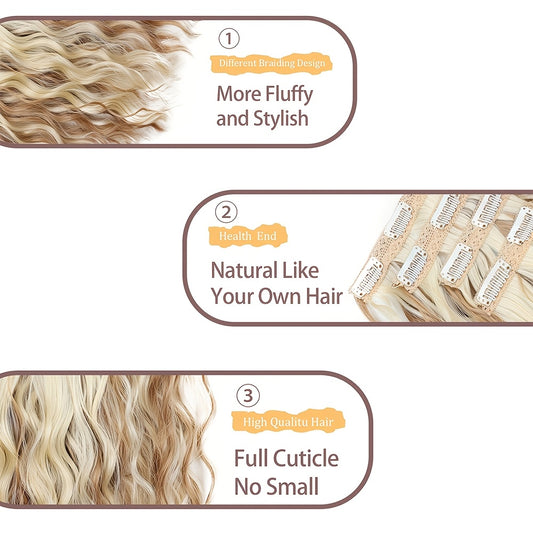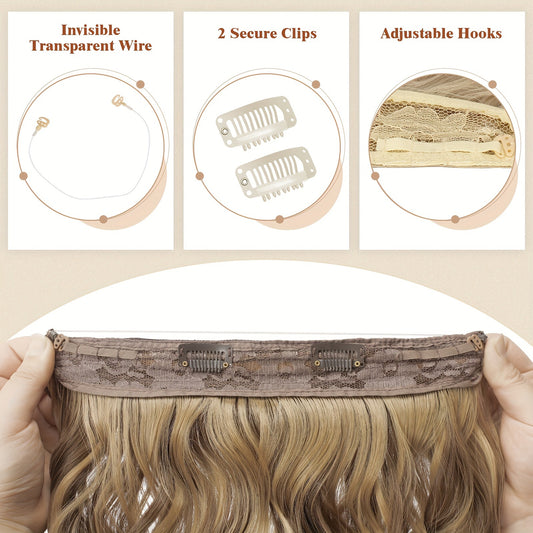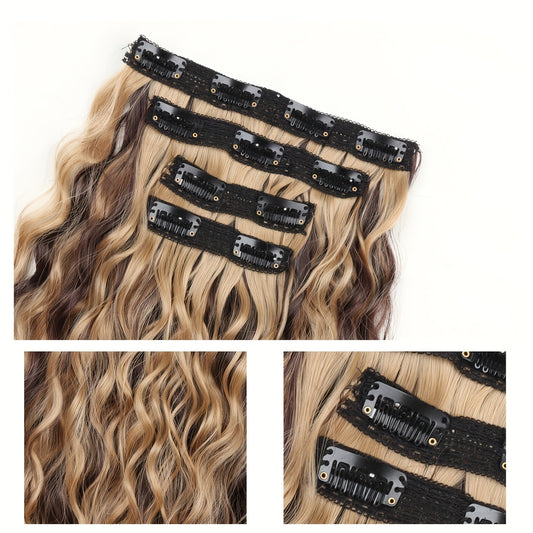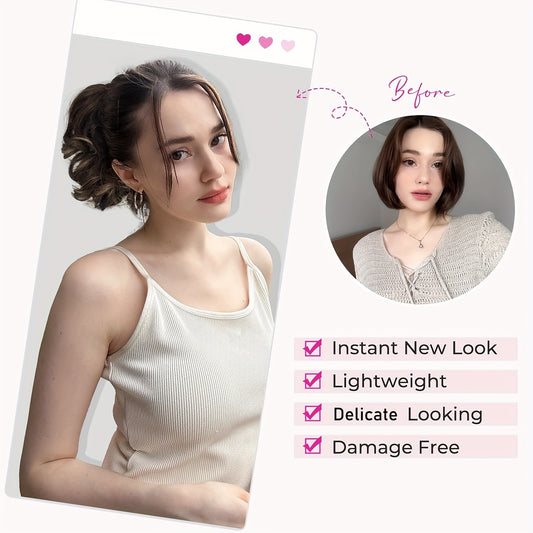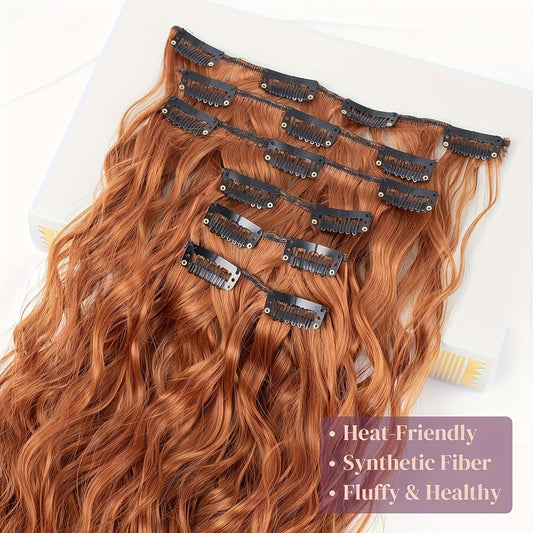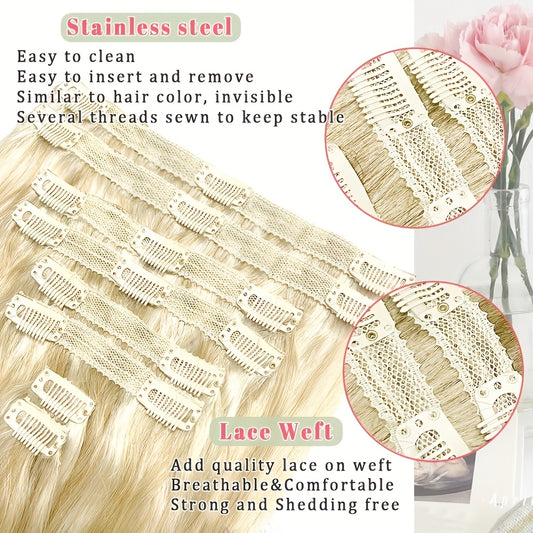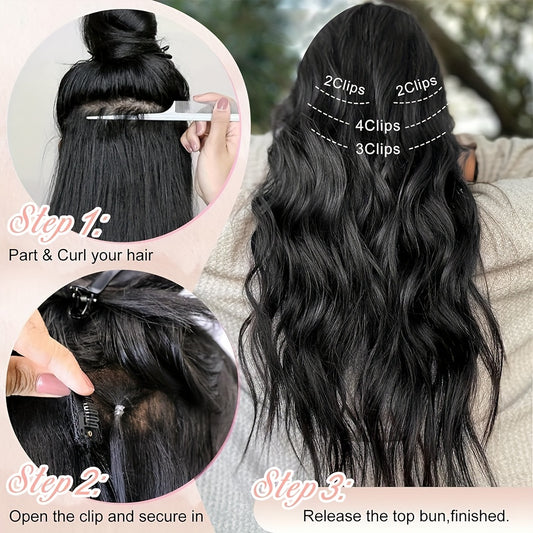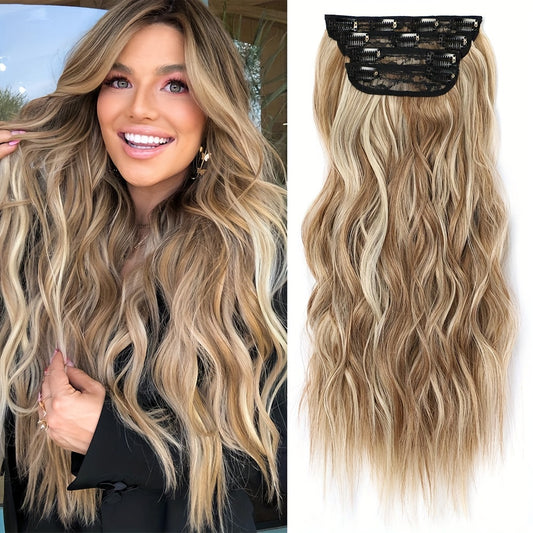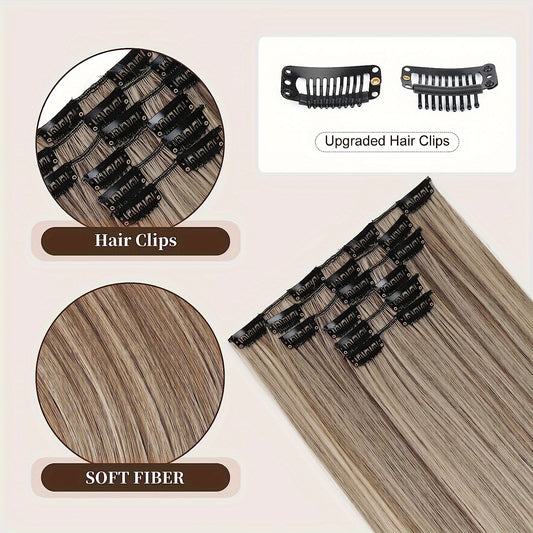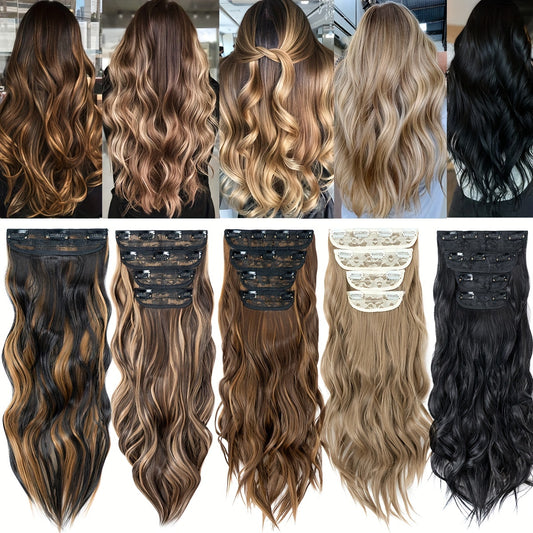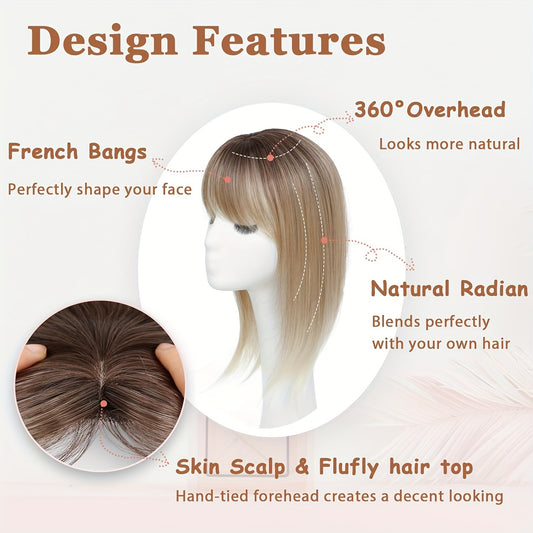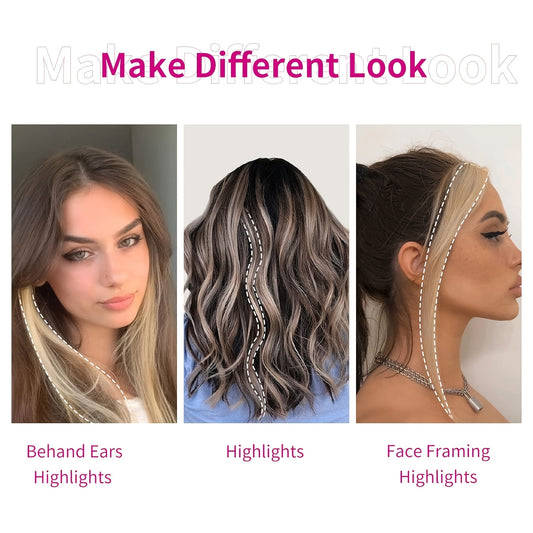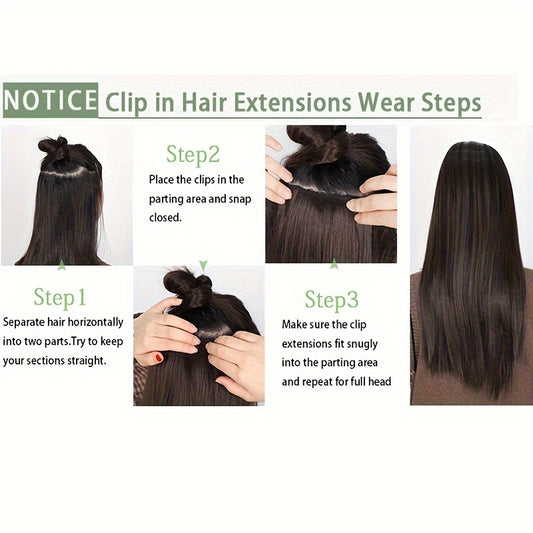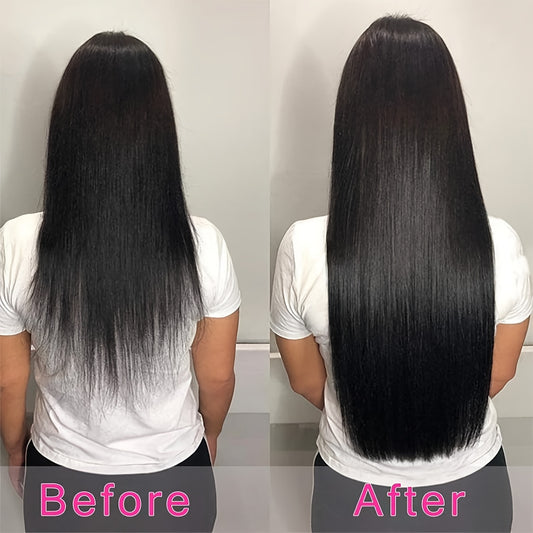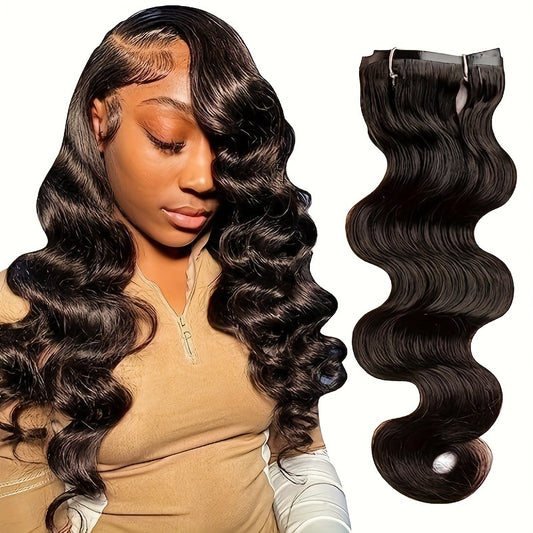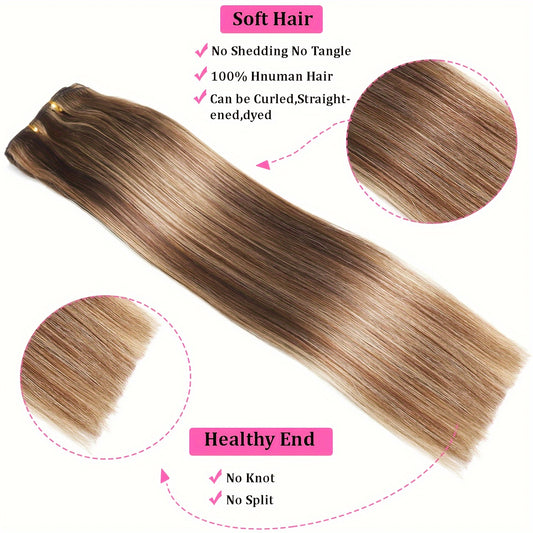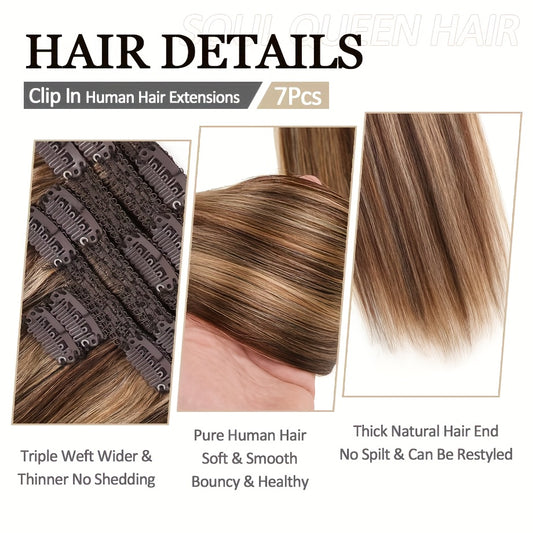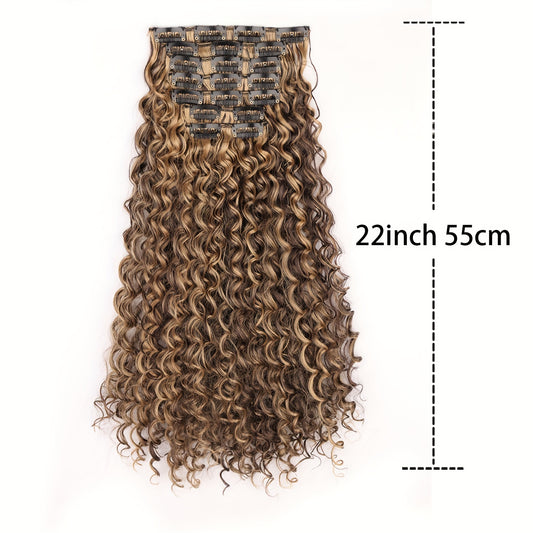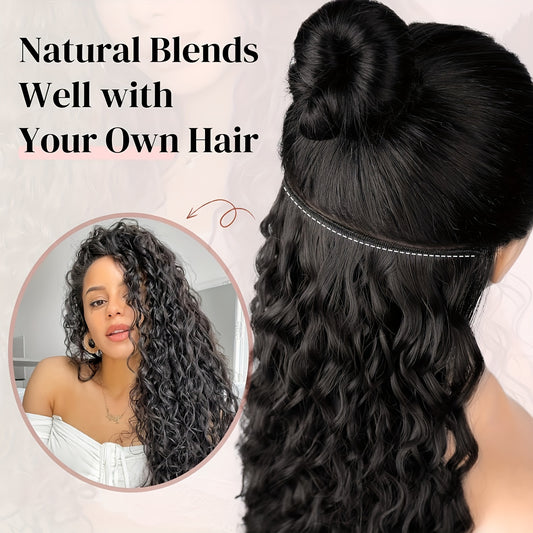About Clip In Hair Extensions
Clip on extensions are modular wefts fitted with small pressure clips. They install under the top layer of your own hair and remove in seconds. You choose how many wefts to use each day: a full map for transformation or two to four pieces to complete a perimeter. Because the system is removable, weight and heat exposure can be managed precisely. You are not committing to constant wear or adhesives; you are choosing a repeatable, low friction routine that serves work, events, and content days without salon dependence.
Construction types
Machine sewn wefts have a stitched seam and carry higher density per inch. They are durable and well suited to the nape where friction is highest. Seamless or injection wefts present a flat polyurethane style base that disappears under fine crowns; they lay close to the head and reduce bulk in upper rows. Hybrid sets mix both: a sturdy machine or flat piece low, and slim seamless pieces above. Clip quality matters as much as hair: consistent spring tension, smooth hinges, and silicone lined teeth protect roots and stabilize anchors.
Remy human hair with cuticles aligned in one direction is the standard for predictable styling. Aligned cuticles reduce friction, resist tangling, and reflect a soft, natural sheen rather than a plastic glare. Minimal processing and honest heat limits in degrees, not adjectives, indicate material discipline. Those signals predict outcome far better than slogans.
Weight selection matrix
Weight (grams) controls end authority. The camera reads the last third of the outline first. Too little weight looks long but unfinished; too much weight in the wrong zone looks bulky and risks exposure. Use this matrix. Ninety to one hundred twenty grams: subtle fullness for layered natural hair; best in soft waves and low product routines. One hundred thirty to one hundred sixty grams: everyday density that photographs clean without heavy feel; suitable for most heads and haircuts. One hundred seventy to two hundred thirty grams: plush perimeter for blunt cuts, thicker strands, studio lighting, or humid climates where waves relax. Above two hundred thirty grams: specialty builds for very dense natural hair or precise straight looks under hard light.
Distribute by zone. The lowest row sets stability. The mid row along the occipital curve builds body. Side panels remove temple hollows that appear in three quarter photos. If the front view collapses near the cheeks, add two slim temple pieces; adding a heavier back row rarely fixes facial balance. Proportion is realism.
Length by landmarks
Length is a body proportion decision. On many average height frames, 14 inches lands near the collarbone, 16 at upper chest, 18 at mid chest, 20 at lower chest, 22 near ribs, 24 toward the waist, and 26 into waist or upper hip. Waves read one to two inches shorter; tight curls read more. Measure from behind the ear to the desired landing point to simulate the hang of a weft. Test the measure while wearing common necklines and outerwear; long hair should frame garments, not fight zippers and collars.
If you want a straight, freshly cut edge, plan slightly more grams than for a wave finish. Straight photos never forgive a weak perimeter. A half inch micro trim after the first two wears often produces a decisive line with no need to buy more weight.
End draw and edge clarity
Single drawn hair tapers toward the tips like natural growth and moves easily; it excels in wave finishes. Double drawn hair carries density deeper into the bottom third and reads like a recent cut—square, intentional, and calm in straight or beveled styles. Choose by finish goal and camera needs rather than by theory. If only a taper is available, a micro trim of half an inch to one inch converts the outline from soft to deliberate without losing the idea of length.
Judge with proof. A cropped, daylight back view of ends at rest tells more truth about quality than any description. If the page presents only styled ends without a still crop, request the end shot; it is the most useful image in long hair purchasing.
Texture and effort
Straight displays length most clearly and shows static fastest; it rewards clean handling and low heat. Body wave is the universal blender and requires fewer passes: one low heat smoothing pass brushes it straight; one set and a full cool creates soft bends. Loose curl and deep wave provide defined pattern; blending is easiest when coil diameter aligns with your own hair. Coily textures need clear diameter and shrinkage labeling, plus defined and brushed out examples so behavior is predictable.
Make the texture choice by routine, not identity. If most days are blowouts, straight fits. If you switch between smooth and bend, body wave saves time. If you live in curls, match coil scale so the seam disappears. The right choice reduces heat cycles and product dependence.
Color science simplified
Match undertone first—cool, neutral, warm—then match depth. Verify in daylight by a window; indoor bulbs tilt yellow or blue and can mislead. If you sit between shades, slightly lighter is safer because human hair accepts cooling or deepening with demi toners; lifting lighter raises cuticles and shortens life. Rooted and balayage options blur seams at parts and temples and support natural root growth. Mixing a slightly deeper lowlight piece under a lighter piece builds dimension that looks like sun rather than dye.
Record your match with a quick daylight photo next to your mid lengths and store the shade code, grams, and texture. Reorders become exact and seasonal adjustments become calm.
Placement patterns
Classic center part: lowest wide weft above the nape, a second wide weft where the head begins to curve, one or two medium wefts along the occipital arc, and paired temple pieces just behind the hairline on each side. Deep side part: mirror the classic map but add one extra narrow piece on the heavy side to maintain balance when swept. Shorter crown or fine hair: keep rows lower and reduce piece count near the crown; your top layer is a concealment budget that should not be overspent.
Anchoring method: tease lightly or dust a small root texture powder where clips will sit; avoid oils at anchors. Close the center clip first, then the sides to spread load evenly. Support the row with your free hand while brushing so you are not pulling on the seam. Tiny choices prevent large discomfort.
Face framing logic
Front balance is often the difference between believable and artificial. Temples can look hollow in three quarter angles, especially with layered haircuts. Two slim panels trimmed on a gentle diagonal fill that area without adding bulk. If your haircut has short face framing, select one pair of narrow pieces a shade deeper or slightly cooler than the back; the micro shadow near the face sharpens jawline contours on camera without heavy makeup. Match the angle of your cut when trimming extension side pieces to avoid a shelf at the cheek.
For center parts, the aim is mirror symmetry. For side parts, the aim is visual symmetry, which is not equal weight; the heavy side needs slightly more hair to read balanced.
Heat and finishing policy
Keep tool temperatures at or under one hundred eighty Celsius or three hundred fifty Fahrenheit. One slow pass beats three fast passes. For waves, curl the back in alternating directions and the front away from the face. Let sections cool fully before brushing into a single pattern; cooling sets the bonds you shaped with heat. Spray flexible hold onto the brush, not directly onto hair, to keep sheen and prevent stiff areas. Finish with a pea of serum on mid lengths and ends only.
For straight days, bevel the last half inch to one inch to create a clean, haircut like edge. For coily days, define with water first, then product; fluff only when everything is fully dry. Avoid heavy oils at the roots; anchors rely on clean texture for grip.
Friction management
Long hair rubs against coats, scarves, seat backs, and straps. Control friction by brushing once after removing outerwear, choosing smooth strap bags, zipping jackets with hair swept forward, and sweeping hair over one shoulder during long seating. A satin pouch protects wefts in a backpack. These moves are not glamour; they are the habits that keep ends sharp for months instead of weeks.
Wind management is simple: keep the crown layer generous, place a slim cover piece one step higher for outdoor days, shift the part a few millimeters if a seam wants to flash, and use a temporary ear tuck in transitions between buildings. Motion control beats extra product.
Daily routine
Morning: brush natural hair and wefts, install using your chosen map, set shape with low to moderate heat, allow complete cooling, and brush once to lock the pattern. Midday: after outerwear or long chair sessions, brush once to reset the hem. Evening: brush, remove clip ons, coil wefts in a gentle U, and store in satin away from heat and sunlight. Weekly: wash extensions every ten to fifteen wears or when product buildup appears, air dry as far as possible, and keep temperatures capped.
Do not sleep in clip ons. Rotate exact clip positions a few millimeters between wears to avoid loading the same follicles repeatedly. Comfort is a requirement; if you feel pressure, remove one piece for daily use and add it back for events.
Washing and storage
Shampoo your natural hair first. Clean extensions in cool or lukewarm water with a small amount of gentle shampoo, squeezing through lengths without rough scrubbing. Rinse thoroughly. Condition from mid lengths to ends, detangle with a wide tooth comb while saturated, then rinse cool to close cuticles. Blot with microfiber—no wringing—and air dry flat or on a hanger. Define or smooth only when fully dry. Clarify occasionally if product stacking dulls the fiber. Store brushed pieces in a satin pouch.
Replace a tired clip rather than the entire piece. Seal cut edges if you resize a weft. Schedule a half inch micro trim after two to four weeks of wear; the edge will read new again with minimal loss of length.
Workflows for common contexts
Office days: beveled blowout or soft bend that clears collars and headsets; hem reads clean on camera. Teaching or webinars: wave sheets that remain coherent under soft lights; finish with spray on the brush. Evenings out: uniform curls brushed into a single pattern with a one pass bevel at the ends. Travel: compact claw clip twist during movement with a brush reset on arrival. Gym: remove pieces and reinstall after; sweat salts are not friends of cuticles.
Quality verification steps
Before first wear, photograph the ends in daylight on a white background. That image becomes your baseline for future trims or warranty communication. Count clips and inspect spring tension; replace any weak springs early. Test heat on a single small weft first and record the exact temperature that produced your best result. Label side pieces inside the pouch so temple placement is repeatable. Your goal is to turn success into a saved pattern, not a lucky day.
Human hair versus synthetic
Human hair accepts moderate heat, toners that cool or deepen, and behaves predictably across climates when handled well. Synthetic fibers resist heat and hold a single preset shape but can shine unnaturally under LEDs. Blends vary widely and are not consistent from brand to brand. If you need flexibility—straight one day, wave the next—human hair remains the reliable choice for clip ons. If you need a single event shape at a low price, heat safe synthetics can serve, but respect their narrower limits.
Accessibility and inclusion
Pair shade names with numeric descriptors such as level 6 neutral brown so color blind buyers can map choices. Provide alt text that includes method, length, texture, undertone, and draw. Ensure that filter controls are keyboard accessible and that changes announce to screen readers. Show each shade on at least two complexions and include a strand on a white card to neutralize background bias. Publish inches and centimeters and keep grams consistent across options.
Clarity helps everyone. When a page shows the same shade straight and waved, front and back, with a cropped end shot at rest, buyers of all experience levels make accurate selections on the first try.
Risk boundaries
Do not sleep in clip ons. Do not exceed the stated heat limit. Do not place many pieces high under a thin crown. Do not apply heavy oils at the roots; anchors require clean texture. Do not attempt to lift extension color lighter; tone darker or cooler instead. If you have skin or scalp conditions, consult a professional before choosing a method. Boundaries are not warnings; they are safeguards that keep comfort and longevity high.
If any step feels confusing, slow down and return to fundamentals: section cleanly, close center clips first, distribute weight, cap heat, allow complete cooling, and brush once into the final pattern. Small decisions repeated calmly produce the best results.
Checklist summary
Plan: choose weight for your haircut and finish goal; choose length by body landmark; confirm texture by routine; match color by undertone in daylight; record shade code, grams, and tool temperatures. Install: keep rows low, crown generous, center clip first, sides next, temples balanced. Finish: cap heat, cool fully, brush once, spray on the brush, serum only on ends. Maintain: brush after outerwear, store in satin, wash on cadence, trim a half inch seasonally, replace tired clips.
Outcome: a perimeter that reads deliberate in photos and in motion, with comfort that lets you forget you are wearing anything at all.
Buyer page cues
Clear grams by set, heat caps in degrees, daylight end crops, return basics for unopened hair, and a short care card signal material discipline. Filters for grams, texture, and shade family help buyers reach a match without scrolling endlessly. A three step how to—section, anchor, blend—placed near the hero reduces support tickets more than extra adjectives ever will.
Pages that show proof and numbers outperform pages that rely on lifestyle metaphors. Precision is trust.
Summary
Clip on extensions offer a precise, removable way to alter length and density while keeping daily control over weight, heat, and comfort. Choose grams for the photo you want, select length by landmarks, match color by undertone in daylight, and map pieces to protect the crown. Cap heat, cool fully, brush once, and store in satin. With those small, repeatable choices, the result reads like your hair—only longer and cleaner—day after day without salon dependence.
When uncertain, simplify: section, anchor, blend, cool, brush. That rhythm scales from a two piece perimeter fix to a full set with the same steady outcome.
Mapping examples
Minimal perimeter: one medium back weft and two temple pieces sharpen the outline without changing bulk. Everyday set: widest back row, a mid structural row, a pair of sides, and slim cover pieces high on each side for wind. Straight feature day: add grams at the nape and occipital with double drawn ends, cap heat, and bevel the last inch. Content marathon: distribute weight across rows and rotate clip positions to protect follicles over long wear.
Service and support signals
Pages that publish grams calculators, daylight shade photos, heat caps in degrees, and repair guides are easier to own. Spare clip kits and concise care cards reduce downtime. Numbers and proof images beat slogans every time.
Mapping examples
Minimal perimeter: one medium back weft and two temple pieces sharpen the outline without changing bulk. Everyday set: widest back row, a mid structural row, a pair of sides, and slim cover pieces high on each side for wind. Straight feature day: add grams at the nape and occipital with double drawn ends, cap heat, and bevel the last inch. Content marathon: distribute weight across rows and rotate clip positions to protect follicles over long wear.
Service and support signals
Pages that publish grams calculators, daylight shade photos, heat caps in degrees, and repair guides are easier to own. Spare clip kits and concise care cards reduce downtime. Numbers and proof images beat slogans every time.
Mapping examples
Minimal perimeter: one medium back weft and two temple pieces sharpen the outline without changing bulk. Everyday set: widest back row, a mid structural row, a pair of sides, and slim cover pieces high on each side for wind. Straight feature day: add grams at the nape and occipital with double drawn ends, cap heat, and bevel the last inch. Content marathon: distribute weight across rows and rotate clip positions to protect follicles over long wear.
Service and support signals
Pages that publish grams calculators, daylight shade photos, heat caps in degrees, and repair guides are easier to own. Spare clip kits and concise care cards reduce downtime. Numbers and proof images beat slogans every time.
Mapping examples
Minimal perimeter: one medium back weft and two temple pieces sharpen the outline without changing bulk. Everyday set: widest back row, a mid structural row, a pair of sides, and slim cover pieces high on each side for wind. Straight feature day: add grams at the nape and occipital with double drawn ends, cap heat, and bevel the last inch. Content marathon: distribute weight across rows and rotate clip positions to protect follicles over long wear.
Service and support signals
Pages that publish grams calculators, daylight shade photos, heat caps in degrees, and repair guides are easier to own. Spare clip kits and concise care cards reduce downtime. Numbers and proof images beat slogans every time.
Mapping examples
Minimal perimeter: one medium back weft and two temple pieces sharpen the outline without changing bulk. Everyday set: widest back row, a mid structural row, a pair of sides, and slim cover pieces high on each side for wind. Straight feature day: add grams at the nape and occipital with double drawn ends, cap heat, and bevel the last inch. Content marathon: distribute weight across rows and rotate clip positions to protect follicles over long wear.
Service and support signals
Pages that publish grams calculators, daylight shade photos, heat caps in degrees, and repair guides are easier to own. Spare clip kits and concise care cards reduce downtime. Numbers and proof images beat slogans every time.
Mapping examples
Minimal perimeter: one medium back weft and two temple pieces sharpen the outline without changing bulk. Everyday set: widest back row, a mid structural row, a pair of sides, and slim cover pieces high on each side for wind. Straight feature day: add grams at the nape and occipital with double drawn ends, cap heat, and bevel the last inch. Content marathon: distribute weight across rows and rotate clip positions to protect follicles over long wear.
Service and support signals
Pages that publish grams calculators, daylight shade photos, heat caps in degrees, and repair guides are easier to own. Spare clip kits and concise care cards reduce downtime. Numbers and proof images beat slogans every time.
Mapping examples
Minimal perimeter: one medium back weft and two temple pieces sharpen the outline without changing bulk. Everyday set: widest back row, a mid structural row, a pair of sides, and slim cover pieces high on each side for wind. Straight feature day: add grams at the nape and occipital with double drawn ends, cap heat, and bevel the last inch. Content marathon: distribute weight across rows and rotate clip positions to protect follicles over long wear.
Service and support signals
Pages that publish grams calculators, daylight shade photos, heat caps in degrees, and repair guides are easier to own. Spare clip kits and concise care cards reduce downtime. Numbers and proof images beat slogans every time.
Mapping examples
Minimal perimeter: one medium back weft and two temple pieces sharpen the outline without changing bulk. Everyday set: widest back row, a mid structural row, a pair of sides, and slim cover pieces high on each side for wind. Straight feature day: add grams at the nape and occipital with double drawn ends, cap heat, and bevel the last inch. Content marathon: distribute weight across rows and rotate clip positions to protect follicles over long wear.
Service and support signals
Pages that publish grams calculators, daylight shade photos, heat caps in degrees, and repair guides are easier to own. Spare clip kits and concise care cards reduce downtime. Numbers and proof images beat slogans every time.
Mapping examples
Minimal perimeter: one medium back weft and two temple pieces sharpen the outline without changing bulk. Everyday set: widest back row, a mid structural row, a pair of sides, and slim cover pieces high on each side for wind. Straight feature day: add grams at the nape and occipital with double drawn ends, cap heat, and bevel the last inch. Content marathon: distribute weight across rows and rotate clip positions to protect follicles over long wear.
Service and support signals
Pages that publish grams calculators, daylight shade photos, heat caps in degrees, and repair guides are easier to own. Spare clip kits and concise care cards reduce downtime. Numbers and proof images beat slogans every time.
Mapping examples
Minimal perimeter: one medium back weft and two temple pieces sharpen the outline without changing bulk. Everyday set: widest back row, a mid structural row, a pair of sides, and slim cover pieces high on each side for wind. Straight feature day: add grams at the nape and occipital with double drawn ends, cap heat, and bevel the last inch. Content marathon: distribute weight across rows and rotate clip positions to protect follicles over long wear.
Service and support signals
Pages that publish grams calculators, daylight shade photos, heat caps in degrees, and repair guides are easier to own. Spare clip kits and concise care cards reduce downtime. Numbers and proof images beat slogans every time.
Mapping examples
Minimal perimeter: one medium back weft and two temple pieces sharpen the outline without changing bulk. Everyday set: widest back row, a mid structural row, a pair of sides, and slim cover pieces high on each side for wind. Straight feature day: add grams at the nape and occipital with double drawn ends, cap heat, and bevel the last inch. Content marathon: distribute weight across rows and rotate clip positions to protect follicles over long wear.
Service and support signals
Pages that publish grams calculators, daylight shade photos, heat caps in degrees, and repair guides are easier to own. Spare clip kits and concise care cards reduce downtime. Numbers and proof images beat slogans every time.
Mapping examples
Minimal perimeter: one medium back weft and two temple pieces sharpen the outline without changing bulk. Everyday set: widest back row, a mid structural row, a pair of sides, and slim cover pieces high on each side for wind. Straight feature day: add grams at the nape and occipital with double drawn ends, cap heat, and bevel the last inch. Content marathon: distribute weight across rows and rotate clip positions to protect follicles over long wear.
Service and support signals
Pages that publish grams calculators, daylight shade photos, heat caps in degrees, and repair guides are easier to own. Spare clip kits and concise care cards reduce downtime. Numbers and proof images beat slogans every time.
Mapping examples
Minimal perimeter: one medium back weft and two temple pieces sharpen the outline without changing bulk. Everyday set: widest back row, a mid structural row, a pair of sides, and slim cover pieces high on each side for wind. Straight feature day: add grams at the nape and occipital with double drawn ends, cap heat, and bevel the last inch. Content marathon: distribute weight across rows and rotate clip positions to protect follicles over long wear.
Service and support signals
Pages that publish grams calculators, daylight shade photos, heat caps in degrees, and repair guides are easier to own. Spare clip kits and concise care cards reduce downtime. Numbers and proof images beat slogans every time.
Mapping examples
Minimal perimeter: one medium back weft and two temple pieces sharpen the outline without changing bulk. Everyday set: widest back row, a mid structural row, a pair of sides, and slim cover pieces high on each side for wind. Straight feature day: add grams at the nape and occipital with double drawn ends, cap heat, and bevel the last inch. Content marathon: distribute weight across rows and rotate clip positions to protect follicles over long wear.
Service and support signals
Pages that publish grams calculators, daylight shade photos, heat caps in degrees, and repair guides are easier to own. Spare clip kits and concise care cards reduce downtime. Numbers and proof images beat slogans every time.
Mapping examples
Minimal perimeter: one medium back weft and two temple pieces sharpen the outline without changing bulk. Everyday set: widest back row, a mid structural row, a pair of sides, and slim cover pieces high on each side for wind. Straight feature day: add grams at the nape and occipital with double drawn ends, cap heat, and bevel the last inch. Content marathon: distribute weight across rows and rotate clip positions to protect follicles over long wear.
Service and support signals
Pages that publish grams calculators, daylight shade photos, heat caps in degrees, and repair guides are easier to own. Spare clip kits and concise care cards reduce downtime. Numbers and proof images beat slogans every time.
Customer reviews
- Installed a full map in nine minutes before a shoot; once I beveled the ends, the outline looked like a brand new cut. — Riley Morgan, New York, USA ⭐⭐⭐⭐⭐
- The daylight color tip worked; a neutral rooted shade blends under sun and office LEDs, and my part stays invisible. — Daniel Carter, Toronto, Canada ⭐⭐⭐⭐⭐
- My scalp is picky, but a lighter daily map plus two temple pieces for events kept everything comfortable and secure. — Amelia Hughes, London, United Kingdom ⭐⭐⭐⭐
- Body wave aligns with my schedule—one pass for smooth weekdays, plush bends on weekends—and removal is quick. — Chloe Bennett, Sydney, Australia ⭐⭐⭐⭐⭐
- Two slim side panels fixed the hollow by my cheeks; a half inch micro trim cleaned the perimeter perfectly. — Sofia Martin, Milan, Italy ⭐⭐⭐⭐⭐
- Shipping took a day longer, so four stars, but the clips have real spring and the Remy hair styles predictably after cooling. — Harper Wright, Chicago, USA ⭐⭐⭐⭐
- On video calls the silhouette stays steady with a soft sheen; hardware never flashes thanks to the lower map. — Grace Allen, Los Angeles, USA ⭐⭐⭐⭐⭐
- Windy walk across the river and the higher cover piece plus a tiny part shift kept everything hidden outdoors. — Hannah Collins, Manchester, United Kingdom ⭐⭐⭐⭐⭐
- First time user here—the section–anchor–blend rhythm clicked on day one; I saved my shade code and grams for reorders. — Olivia Tremblay, Montreal, Canada ⭐⭐⭐⭐⭐
- I pull them out for workouts and reinstall for dinner; a single brush resets the hem and tangling stayed minimal. — Charlotte King, Melbourne, Australia ⭐⭐⭐⭐⭐


